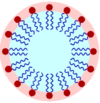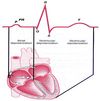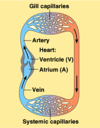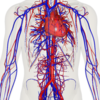Transport in Animals, Plants, Insects (3) Flashcards
what is the structure of the substance carrying oxygen in the blood in RBCs
A RBC contains molecules of haemoglobin, made of 4 sub-units. Each sub-unit is a conjugated polypeptide chain in an alpha helix, i.e. GLOBIN (protein) + HAEM (prosthetic group)
There are 2 alpha chains and 2 beta chains.
Haem has the same structure as chlorophyll (porphyrin ring, iron in the centre)

outline the route of the mammalian respiratory system
pharynx, larynx, glottis

trachea, bronchi, LUNGS: bronchioles, alveoli- squamous epithelium + capillary walls
explain the effect of light intensity on the rate of transpiration
- IN THE DARK- stomata close, drastically reducing the rate of transpiration
- once there is enough light to cause the STOMATA TO OPEN (which is quite low), increasing light intensity further has no effect

what are the types of circulatory system (+ characteristics)
OPEN blood or haemolymph/haemocoel bathes organs directly

- NO VESSELS*
- blood pumps at low pressure, circulation is slow, there is little control over direction of flow*
- INSECTS*
CLOSED a heart pumps blood through arteries, arterioles, capillaries (site of exchange), venules, veins and back to the heart i.e. in a continuous systems of vessels
- blood is pumped at high pressure by a muscular heart, producing rapid flow*
- CAPILLARIES: site of exchange between organs/tissues by fluid leaving/entering vessels (caps) for metabolites- O2, CO2, glucose, urea*
what is used to measure to volume of air moving in and out of the thorax in a human
a spirometer
due to low pressure (kPa) of blood in the veins why does it not pool
Semi-lunar valves in the veins close, negating/against the effect of gravity
what is symplast (1 mark)
The route taken by water as it moves through cells from cytoplasm of one cell to the cytoplasm of the adjacent cell through plasmodesmata.

what are the differences between PLASMA, TISSUE FLUID & LYMPH in terms of hydrostatic pressure, oncotic pressure, cells, proteins and fats
HYDROSTATIC PRESSURE high hydrostatic pressure at arterial end in blood plasma, low in tissue fluid + lymph
ONCOTIC PRESSURE more negative in blood plasma, less negative in tissue fluid + lymph
CELLS RBCs & WBCs in blood plasma, WBCs in lymph
PROTEINS plasma proteins in blood plasma, low in lymph
FATS present in lymph
what happens after the chloride shift in the lungs (3 marks)
At the lungs, hydrogen carbonate ions HCO3- re-enter RBCs and chloride ion Cl- leave the RBC to balance the charge.
HCO3- are reconverted to CO2 by the action of carbonic anhydrase.
CO2 DIFFUSES OUT + ENTERS THE ALVEOLI.

give four differences between structure for arteries capillaries and veins
COLLAGEN FIBRES:
A present, thick C absent V present, thin
ELASTIC + MUSCULAR FIBRES:
A present, thick C absent V present, thin
ENDOTHELIUM:
A present C present V present
VALVES:
A + C absent V semilunar valves at intervals
name the 7 parts of the root of a dicotyledonous plant
-VASCULAR BUNDLE in the middle to provide stability eg. against wind that pulls the plant -XYLEM ‘cross’ in the middle -PHLOEM (4 circles around the xylem) -ENDODERMIS around the vascular bundle -CORTEX(parenchyma) -EPIDERMIS -EXODERMIS containing ROOT HAIR

what is the outcome of Fick’s Law
the larger the area and the larger the difference in concentration and the thinner the surface, the faster the rate of diffusion
what is simple diffusion
when a substance goes through the phospholipid bilayer and does not need a protein carrier or channel (this would be facilitated diffusion)
what is the function of COLLAGEN and SMOOTH MUSCLE in artery+arteriole walls
collagen- thick outer layer** of **non-elastic** fibrous tissue to **prevent over-expansion** of vessel under **high pressure

smooth muscle- to allow narrowing of vessel lumen by contraction of muscle. Important for arterioles bc it controls blood flow + direction to capillaries eg. in thermoregulation- vasodilation due to adrenaline, endotherms conserving heat, fight/flight
what are the advantages and disadvantages of different circulatory systems
-open circulatory
- little control over direction of flow
- low pressure of flow
- low speed of flow
- no carriage of O2 in haemolymph (no separation or mixing)

outline the 4 stages involved in EXPIRATION
- diaphragm muscles relax and the diaphragm becomes dome-shaped
- the external intercostal muscles relax, the internal intercostal muscles contract, ribs and sternum move down and inwards
- volume of thorax (and therefore the lungs) is decreased, pressure in the lungs is increased above atmospheric pressure
- air flows out of thorax
what is the first link in the insect respiratory system chain
1
SPIRACLES are
- the* opening of the tracheae to the exterior.
- opened and closed by a sphincter (to prevent fungal infection, reduce water loss and regulate ventilation)*
- lined with fine hairs to (to reduce water loss and remove potential infection)*
what is the T wave
repolarisation of ventricle
+ they fill with blood

what is the vital capacity of lungs
the maximum volume of air that can be breathed in or out
what is the role of an artery+arteriole
to carry oxygenated blood from the heart to tissues under high pressure
(not oxygenated in pulmonary artery + umbilical cord)
give three adaptations that may be found in the stems+roots of hydrophytes + their effects
SMALL ROOTS; water can diffuse directly into the stem + leaf tissues; no need for root uptake
LARGE SURFACE AREA OF SUBMERGED PARTS i.e. stem+roots; maximises area** for **photosynthesis
LACK OF STRONG SUPPORTING STRUCTURE eg. xylem; plant supported by water

which cells and tissue line the airways in the mammalian respiratory system (the layers present)
(image of a bronchus)
INNERMOST: Ciliated columnar epithelia, which have goblet cells interspersed between them.
Cartilage, elastin and smooth muscle surround the epithelia.
Macrophages (phagocytes) are also present which ingest any bacteria that have entered the airways during breathing.

what are the three ways that water moves across leaf cells
APOPLAST pathway
SYMPLAST pathway
VACUOLAR pathway
give three adaptations that may be found in the leaves of hydrophytes + their effect
WIDE FLAT LEAVES; spread** across the water to **maximise SA exposed to light
VERY THIN/NO WAXY CUTICLE; conservation of water is unnecessary, a little wc can help water droplets roll off leaves, aiding stomatal gas exchange
MANY ALWAYS-OPEN STOMATA ON THE UPPER SURFACE OF THE LEAVES/inactive guard cells; no risk of loss of turgor to plant from water loss

label the diagram with tidal volume, vital capacity, total lung capacity, inspiratory reserve volume, expiratory reserve volume, residual volume, breathing rate


outline the route of insects’ respiratory system
spiracles, tracheae, branching of tracheae, tracheoles tracheal fluid, respiring cells
name the parts labelled on the diagram of the human thorax

nasal cavity, larynx, trachea, bronchiole, bronchus, pleural membranes, pleural cavity containing pleural fluid so that membranes slide over each other as we breathe, abdominal cavity, diaphragm, position of the heart, rib, intercostal muscles

what are the 3 factors that determine an organism’s need for a transport/circulatory system
SIZE
SA:VOL
METABOLIC ACTIVITY

what is the function of the bicuspid valve
LEFT-ATRIO VENTRICULAR VALVE
prevents back flow of blood from LV to LA during ventricular systole

what are the three ways in which capillaries are suited to their role
provide a very large SA for exchange of substances between the tissues and blood
total cross-sectional area of the capillaries is always greater than the arteriole supplying them, so rate of blood flow falls. relatively slow movement of blood through capillaries = more time for exchange by diffusion
walls are one endothelial cell thick, giving a thin layer for diffusion/short diffusion distance

what are the types of closed circulation
SINGLE circulation
DOUBLE circulation

what are the 3 mechanisms of movement of water in the xylem
- COHESION TENSION*
- ADHESION- CAPILLARITY*
- ROOT PRESSURE*

describe the apoplast pathway in the root cells to the xylem
what is the function of the aorta
takes oxygenated blood from the left ventricle to the body

give an overview of what the cardiac cycle
+ what is the time taken for each cycle
a sequence of events of a heart beat which pumps blood round the body
it has alternate contractions; systole and relaxations; diastole
these events occur simultaneously in the RHS and LHS
approx. 0.8 secs, tf approx. 80 BPM

what is the Bohr effect (4 marks)
THE BUFFERING OF PROTONS
- the protons are buffered by haemoglobin to prevent a change in pH of the RBCs. This forms haemoglobinic acid
- the binding of protons changes the tertiary structure of the Hb, lowering its affinity for oxygen (allosteric effect)
- O2 is able to dissociate more easily i.e. more will dissociate in the tissues.

name the respiratory surface in fish
gills

what is atrial fibrillation
arrhythmia: abnormal irregular rhythm from atria, ventricles lose regular rhythm
rapid electrical impulses are generated in the atria, they contract very fast/fibrillate but not properly: only some of the impulses are passed onto the ventricles
ventricular fibrillation = less blood supplied to tissues because no time to re-fill aria- ventricles contracting all the time

what is the function of valves in veins/venuoles
semi-lunar valves in the veins prevent backflow and pooling of blood (gravity) when blood is flowing against gravity eg. in the legs
blood flowing away from the heart pushes the valves closed, preventing it from flowing further away

what is the function of ELASTIC FIBRES and ENDOTHELIUM in artery+arteriole walls
- elastic fibres- allow expansion of vessel lumen to withstand high pressure from the heart. Elastic recoil maintains the high pressure + keeps smooth the blood flow.*
- endothelium- inner layer of cells are folded to allow increase in diameter of lumen*

where do contractions in the heart come from + which tissues make up the conduction system
the heart is myogenic i.e. its rhythmic contractions arise from within the cardiac muscle tissue itself (instead of neurogenic i.e. needing nervous impulses to contract)

- the conduction system is an intrinsic regulatory system composed of specialised tissues; 1. SA node, 2. AV node, 3. Bundle of His, 4. Purkinje fibres*
- it is capable of generating and distributing the electrical impulses that stimulate cardiac muscle to contract*
what is a co-transporter protein (1 mark)
A transmembrane protein (a carrier or channel) which transports two substances across the membrane.

name the respiratory surface of plants
CSM of spongy mesophyll cells (which is where air spaces are)

what is the advantage of pressure in double circulatory systems over single
-double circulatory systems maintain high pressure over both gas exchange surfaces- lungs and tissues
It can differentiate the pressure, so the LHS of the heart pumps blood at much higher pressure to the tissues than the RHS to the lungs. Pressure to pulmonary capillaires is much larger than to systemic capillaries.
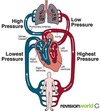
explain the effect of humidity on the rate of transpiration (3 marks)
- As humidity of the air surrounding the plant increases, the concentration of water molecules in the air increases.
- The diffusion gradient between the inside of the leaf and the surrounding air decreases and the transpiration rate decreases.
- Eventually an equilibrium is reached and there is no water vapour loss from the leaf.

where does the heartbeat begin in the conduction system of the heart
Contraction starts at the sino-atrial node (SA node, also known as the pacemaker) which is embedded in the wall of the right atrium close to the entry of the vena cava
A wave of electrical excitation flows over both atria, causing them to contract

what are the 5 necessary properties of a respiratory surface for maximum rate of diffusion across it
- large SA 2. high/active blood supply 3. small diffusion distances/ thin 4. permeable 5. moist
what is bradycardia
SLOW heart rate below 60bpm evenly spaced
(can be due to high fitness levels causing the heart to beat slowly and efficiently)
may need an artificial pacemaker

what is the P wave
atrial systole
electrical charge/depolarisation spreads over both atria from SA node, causing atrial muscleto contract

explain why water moves through the plant
Due to the pull of transpiration
- Transpiration from the leaves/sub-stomatal air creates a water potential gradient with the cells in the leaf
- The ‘pull’ causes the movement of water across the leaf by the 3 pathways: apoplast, symplast, vacuolar
- The ‘pull’ from the water moving in the leaves causes the movement of water through the xylem by mass flow, due to the cohesion & adhesion tensions caused by H-bonds
- The ‘pull’ of the water from the xylem causes the movement of water across the cell of the root by the 3 pathways: a, s, v. The casparian strip in the endoderm causes the apoplast to join the symplast.
- Water moves by osmosis into the root hair cells from the soil. Water diffuses through cell walls into the apoplast pathway.
Water potential is very high (approx. -10kPa) because the soil solution is a very dilute solution of ions

name the 5 parts of the stem of a dicotyledonous plant
-PARENCHYMA in the middle -VASCULAR BUNDLES in a circle around the parenchyma (around edge in order to provide support and strength) -XYLEM on the inner side of the vascular bundle -PHLOEM on the outer side of the vascular bundle -CORTEX is the outer half of the stem -EPIDERMIS around the cortex

what are capillaries
microscopic blood vessels that link veins and arteries, forming an extensive networkt rhoguh all the tissues of the body
capillaries are 10µm in diameter
substances are exchanged through the capillary walls eg. O2, between the tissue cells and the blood
blood enters capillaries in organs from arterioles and is oxygenated. When it leaves to the venuoles it has less oxygen and more carbon dioxide/deoxygenated.
Describe the features of the TRACHEIDS
Spindle-shaped cells with large, bordered, hollow pits on the sides that allow the passage of water + minerals sideways to the living parts of the stem. (lateral movement of water)
The ends of the cells overlap so water moves up the stem.

outline the 4 stages involved in INSPIRATION
- diaphragm muscles contract the diaphragm flattens/lowers
- the external intercostal muscles contract, the internal intercostal muscles relax, ribs and sternum move upwards and outwards
- the volume of the thorax (and therefore lungs) is increased and the pressure in the lungs is decreased below atmospheric pressure
- air flows in
what is a hydrophyte
A plant that lives ; submerged in water of on the surface of water or at the edge of bodies of water
and do not have to conserve water
eg. water lilies

list the 4 stages of inspiration in fish
- mouth opens, floor of buccal cavity is lowered
- buccal cavity expands, volume increases, pressure decreases, water drawn in
- opercular valve is closed, operculum (covering of gills) is closed, cavity fills with water
- operculum moves outwards while closed, which pulls water in from buccal cavity

where are goblet cells found
in the ciliated epithelium of trachea, bronchi and larger bronchioles

what is the function of the pulmonary vein
delivers oxygenated blood from the lungs to the left atrium

what is the function of the inferior vena cava
delivers deoxygenated blood from the trunk and limbs to the right atrium

which 5 properties help the alveoli as a gas exchange surface
- permeable
- large surface area
- thin exchange surface
- moist
- steep conc. grad. between the blood and the alveolar air (maintained by: good blood supply + ventilation of the lungs)
list the 4 stages of expiration in fish
- mouth closes, floor of buccal cavity is raised
- buccal cavity becomes smaller, volume decreases, pressure increases
- opercular valve is open, operculum opens, water flows over gills and out of operculum
- gas exchange occurs between water and blood flowing through gills

how does 1. a large surface area and 2. a thin exchange surface enable the alveoli to be an effective site of gas exchange
The TSA of the alveoli and the numerous surrounding capillaries ensures rapid diffusion of a larger quantity of O2 gas from alveolar air into the blood (and vice versa for CO2)
T: alveolar walls are made of squamous epithelial cells (flat and thin), capillary walls made of endothelial cells which are flat and thin (cap walls are one cell thick)
Therefore the distance between the air in the alveoli and the blood in the capillaries is small.
Thinner the surface, higher the rate of diffusion.

where is squamous epithelium found in the mammalian respiratory system
alveoli (flattened epithelium in smaller bronchioles)
state the equation used in Fick’s Law
rate of diffusion = area of diffusion surface x difference in concentration / thickness of surface over which diffusion takes place
where is epithelium found in the thorax
- Ciliated epithelium in tracheae, bronchi and larger bronchioles*
- flattened epithelium in smaller bronchioles*
squamous epithelium in alveoli

why do the animal + plant transport systems differ
plants are less metabolically active than animals & tf have a much slower transport system ( + gases are transported by diffusion)
the transport sugar in plants is sucrose, which is less reactive than the transport sugar in animals, glucose

what is the transpiration pull
+ how is it measured
- the evaporation of water from the aerial parts of the plant eg. leaves/stomata
the rate of transpiration can be measured by a potometer, and is affected by many factors

what is the function of VEINS + VENUOLES
give three differences from arteries
to carry deoxygenated blood away from tissues to the heart
(pulmonary vein and umbilical vein are oxygenated)
blood goes from very small venuoles to larger veins, veins do not have a pulse, the blood pressure is low and they have valves
veins do not have to withstand high pressure but need a large capacity
skeletal muscle contraction aids blood flow in the veins







